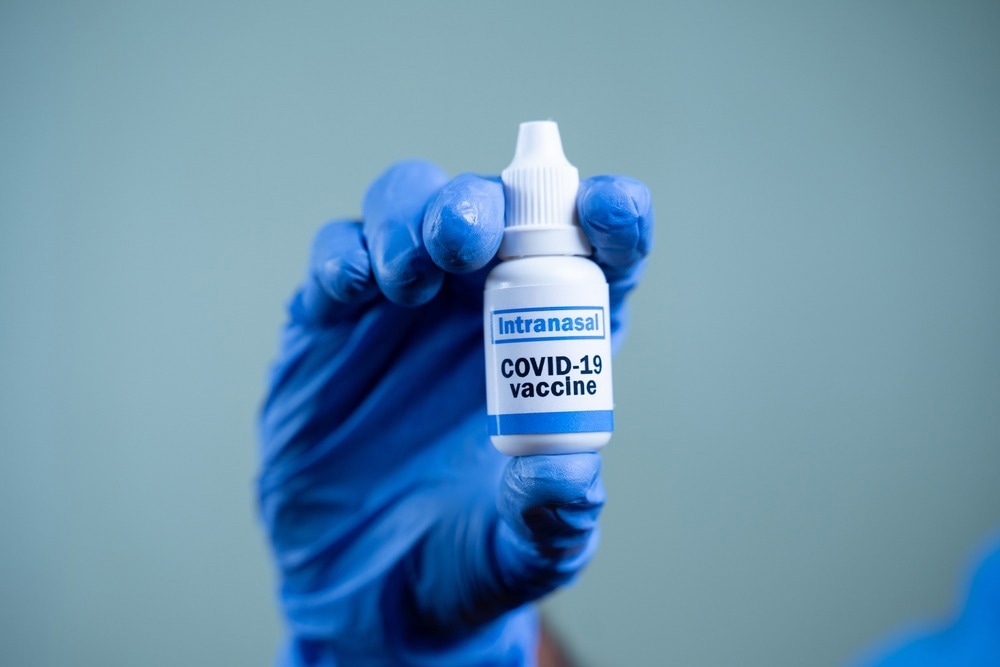The findings of a new study posted to the bioRxiv* preprint server showed that the intranasal SpyCage vaccine platform can be protective against severe acute respiratory syndrome coronavirus 2 (SARS-CoV-2) and may prove to be a versatile and adaptable modality for the formulation of intranasal vaccines that target respiratory pathogens.
 Study: Intranasal virus-particle mimicking vaccine enhances SARS-CoV-2 clearance in the Syrian hamster model. Image Credit: WESTOCK PRODUCTIONS/Shutterstock
Study: Intranasal virus-particle mimicking vaccine enhances SARS-CoV-2 clearance in the Syrian hamster model. Image Credit: WESTOCK PRODUCTIONS/Shutterstock
Background
The SARS-CoV-2 outbreak, which transpired into the global coronavirus disease 2019 (COVID-19) pandemic, could be partly controlled by widespread vaccinations. COVID-19 vaccines prevent both disease and infection transmission.
The last few years have seen an avalanche of rapid vaccine developments that have proven highly effective. Until now, most approved SARS-CoV-2 vaccines require intramuscular (IM) administration. IM vaccines induce high levels of circulating antibodies, memory B cells, and effector CD4+ and CD8+ T cells. However, evidence confirming the induction of mucosal immunity in the respiratory tract by these vaccines remains lacking.
Intranasal vaccination may provide a solution to this shortcoming of the current vaccination protocols. Recent studies have shown that intranasally delivered SARS-CoV-2 vaccines provide mucosal immunity along with the prevention of infection transmission. These vaccines have been shown to reduce viral shedding in mice, hamsters, and nonhuman primates.
About the study
The present study used the SpyCatcher-SpyTag technology to develop a recombinant protein-based intranasal vaccine against SARS-CoV-2. The results proposed an adaptable and flexible method for designing intranasal vaccines targeting respiratory infections.
This experimental study was undertaken to bridge the gap in the lacking mi=ucosal immunogenicity against SARS-CoV-2 by developing a self-assembling protein incorporated into a nanoparticle containing a SpyCatcher domain (SpyCage) for displaying SARS-CoV-2 RBD/SpyTag (RBD+SpyCage) for intranasal vaccination studies in hamsters.
Here, a virus particle that emulates an intranasal vaccine against SARS-CoV-2 was used to conduct preclinical vaccination and challenge tests. Based on the SpyCatcher-SpyTag method, the vaccine candidate was self-assembled on a 60-subunit protein scaffold covalently coated with the SARS-CoV-2 receptor binding domain (RBD).
Additionally, the researchers verified the expected antigen display characteristics by reconstructing the scaffold I3-01 to 3.4A using cryogenic electron microscopy (cryo-EM). Further, the RBD decoration was confirmed through Sodium Dodecyl Sulphate-Polyacrylamide Gel Electrophoresis (SDS-PAGE) and negative-stain transmission electron microscopy (TEM).
The researchers conducted two immunization trials using an intranasal prime and boost vaccination regimen followed by a SARS-CoV-2 challenge in Syrian hamsters. The RBD-grafted SpyCage scaffold (RBD+SpyCage) was used, which was initially evaluated for immunogenicity. A more comprehensive investigation was then carried out to demonstrate the covalent attachment of RBD to the scaffold, which is necessary for antibody production.
The titers of neutralizing antibodies were determined by microneutralization experiments, and the concentrations of RBD-binding immunoglobulin (Ig)G and IgA antibodies were determined by enzyme-linked immunosorbent assay (ELISA).
Study findings
By using cryo-EM reconstruction and refinement of an atomic model of the Apo cage scaffold, the researchers developed a robust, multimeric, spherical protein-based scaffold mimicking the size of a viral particle for intranasal vaccinations. Covalent bonding of SARS-CoV-2 spike-RBD to SpyCage was conducted, which was found to be a stable and saturable platform to display antigens of interest in a mix-and-go fashion.
The SpyCage scaffold was found to be immunogenic, and antigen grafting increased the antibody responses, both to the scaffold and to the antigen. The intranasal administration of RBD+SpyCage increased the clearance of SARS-CoV-2 from the respiratory system.
The results depicted that SARS-CoV-2 was eliminated more effectively from the upper and lower respiratory tracts of animals vaccinated with RBD+SpyCage. Histological analysis revealed that RBD+SpyCage-vaccinated animals had less inflammation and lung damage.
Conclusion
Intranasal immunization with RBD grafted to SpyCage, produced serum IgG responses in hamsters. As a result of this interaction, the viral clearance from the upper and lower respiratory tracts seemed to be more rapid following a viral challenge.
While RBD+SpyCage-vaccinated mice experienced non-significant reductions in weight loss and lung damage – consistent with non-neutralizing antibody response. It was found that the immunogenicity and efficacy of the RBD+SpyCage vaccination required the RBD to be covalently bound to the SpyCage scaffold.
Hence, it was proposed that SpyCage scaffolded antigens can be used as a vaccine platform when administered intranasally. It should be further developed with the addition of intranasal adjuvants to increase immunogenicity.
An additional advantage of SpyCage-derived intranasal vaccines is that they can be easily grafted to scaffolds to induce mucosal immunity, making them ideal for targeting other respiratory viruses. Hence, this platform may be utilized as a rapid-response vaccine to target novel pathogens or pandemics.